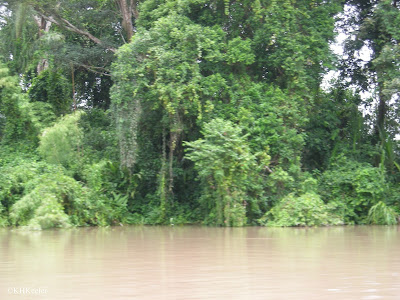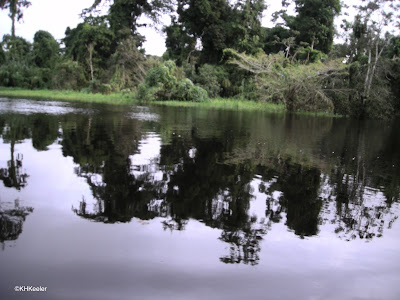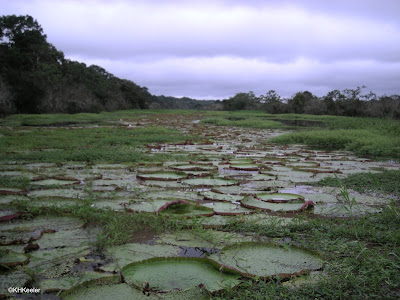I resolved to see it by 1984. Before it was gone.
I actually got to the Amazon Basin in 2011.
A little late.
But, fortunately for me, countries in the Amazon Basin have created great natural reserves to protect the plants and animals. Conservationists point out that some of those reserves are not well-managed and that fine-sounding national laws are not necessarily enforced, but compared to the 1970s, the situation is much improved.
The Amazon Basin is huge. 2.67 million square miles, 40% of South America. The contiguous United States (omitting Alaska and Hawaii) is 3.12 million square miles. The Amazon Basin is the size of 85% of the contiguous United States. Therefore, "seeing it" isn't done in one trip. What I saw was a section of the Amazon Basin in Peru, upriver from the city of Iquitos. (Map of Peru with Iquitos: link. Map of Iquitos showing its position in the Amazon Basin: link The Amazon drains east from Iquitos through the dark green area of the map to the Atlantic in northern Brazil.)
There were two wonders of the world that I knew I wanted to see: 1) forests that flooded 10 or 20 feet during the rainy season, and 2) black and white rivers.
The flooded forests I wanted to see are created anew each year because so much rain falls in the rainy season over the Amazon and on the eastern slope of the Andes that rivers pour over their banks and the land becomes rivers and lakes. The plants visible in this flooded world have roots that can be 20 feet below the surface of the water. That is hard to grasp, even looking at it.
 |
| Flooded forest: the water is more than 10' deep |
 |
| Flooded forest-the water is more than 10' deep |
Being submerged for almost half of the year is hard on plants. Most will suffocate: gas exchange underwater, especially under still water, is quite different from gas exchange in air. Plant cells need gas exchange for their metabolism and most plants cannot get dissolved gasses out of water. The plants in the pictures don't look special, but they are, because they can survive sustained immersion.
The second thing I wanted to see was different-colored rivers. Many rivers combine to become the Amazon River. They run off of mountains or across mudflats or through swamps. Some of those are predictably murky with suspended mud. Because of the soils they cross, these are pale-colored (below).
 |
| white water river, Amazonian Peru |
 |
| black water river, Amazonian Peru |
In the lower Amazon, white water and black water run in parallel toward the Atlantic, side-by-side unmixed--for hundreds of miles. I did not get far enough downriver see to them running next to each other--another trip needed!--but I did see rivers, pictured above, that were either white water or black water.
Beyond my goals of seeing flooded forests and black and white waters, there was lots and lots else that was wonderful. For me two plants stick out.
The first is victoria, the absolutely huge water lily discovered the first year of the reign of England's Queen Victoria (1837) and named for her. I had seen it in large pools, usually indoors, in botanic gardens (at Kew). But in the Amazon--wow! Its leaves can be eight feet in diameter, though the ones I saw were more like five to six feet across. They float on the surface of the water, rising to 15 or 20 feet above the bottom of the lake in the rainy season, dropping down nearly onto the mud in the dry season.
 |
| Victoria amazonica, water lily (water lily family Nymphaceae) |
 |
| Victoria amazonica flower, Peruvian Amazon. The leaves are more than 5' across, the flower a foot in diameter. |
The second plant wonder for me was dyer's mulberry (Maclura tinctoria, mulberry family Moraceae). I wrote about it in a previous post (link). Dyer's mulberry was an important source of yellow dye for Europe in the 1500s. The dye was called old fustic. Explorers could cut the tree directly onto their ships. The wood made the dye, so no other work was needed. Practically free money. So for me it was very exciting to see it. Just like 500 years ago, it was growing out of the water so that we could bring the small boat up under it.
 |
| dyer's mulberry, Maclura tinctoria, Peruvian Amazon |
The trip was a definite success. I saw marvels I had only read about.
My trip was organized by Smithsonian Journeys and International Expeditions. Most days we were afloat: cruising on a river ship and then going out in small boats to see things up close. The Amazon, and tropical rainforest generally, is hot and humid with both annoying and disease-carrying insects. Seeing it from a ship with air conditioning makes the physical experience much more pleasant. I have tramped and camped in tropical rainforest, savoring the too-hot, too-humid, buggy climate that is essential for all the plant and animal wonders there, but ah, sleeping comfortably is a grand thing too.
Comments and corrections welcome.
References
Holway, Tatiana. 2013. The Flower of Empire. Oxford University Press, Oxford. All about the victoria water lily, its discovery and its importance to Victorian England.
Kew Gardens. Victoria amazonica (Giant Waterlily.) Kew Gardens website http://www.kew.org/science-conservation/plants-fungi/victoria-amazonica-giant-waterlily Accessed 8/23/15.
MacCreagh, Gordon. 1926. White Waters and Black. A description of 1923 expedition to the Amazon, it caricatures the academics on the expedition. I found that part hilarious when I read it as a student. The colorful descriptions of the Amazon forest and its creatures stuck in my memory these 40 years. It goes in and out of print.)
Trust for Sustainable Living. Record-breaking giant water lily. The Living Rainforest http://www.livingrainforest.org/about-rainforests/record-breaking-giant-amazon-water-lily/ Accessed 8/23/15.
Kathy Keeler

If you visit the Spanish city of Alicante, you will find out that it is a good change from the typical tourist buzz from the beach resorts around it. You would say that Alicante is the "real Spain" contrasting with the artificial resorts created to cater international tourism.
ReplyDeleteLocated on the Costa Blanca, Alicante has its own beaches, but they are not as famous for them as are the nearby resorts of Benidorm, Santa Pola or Calpe.
See more at-
city tour iquitos
ReplyDeleteSpain boasts a vibrant and exotic culture that attracts tens of thousands of visitors every year. With wonderful beaches, snow peaked mountains, friendly people, beautiful women, amazing nightlife and relaxed lifestyle, Spain can offer everything you can dream of in a travel destination. In fact, it is one of the most visited countries in Europe. If you have difficulties in choosing which cities you should absolutely visit, find out below for the top 3 places you don't want to miss. city tour iquitos